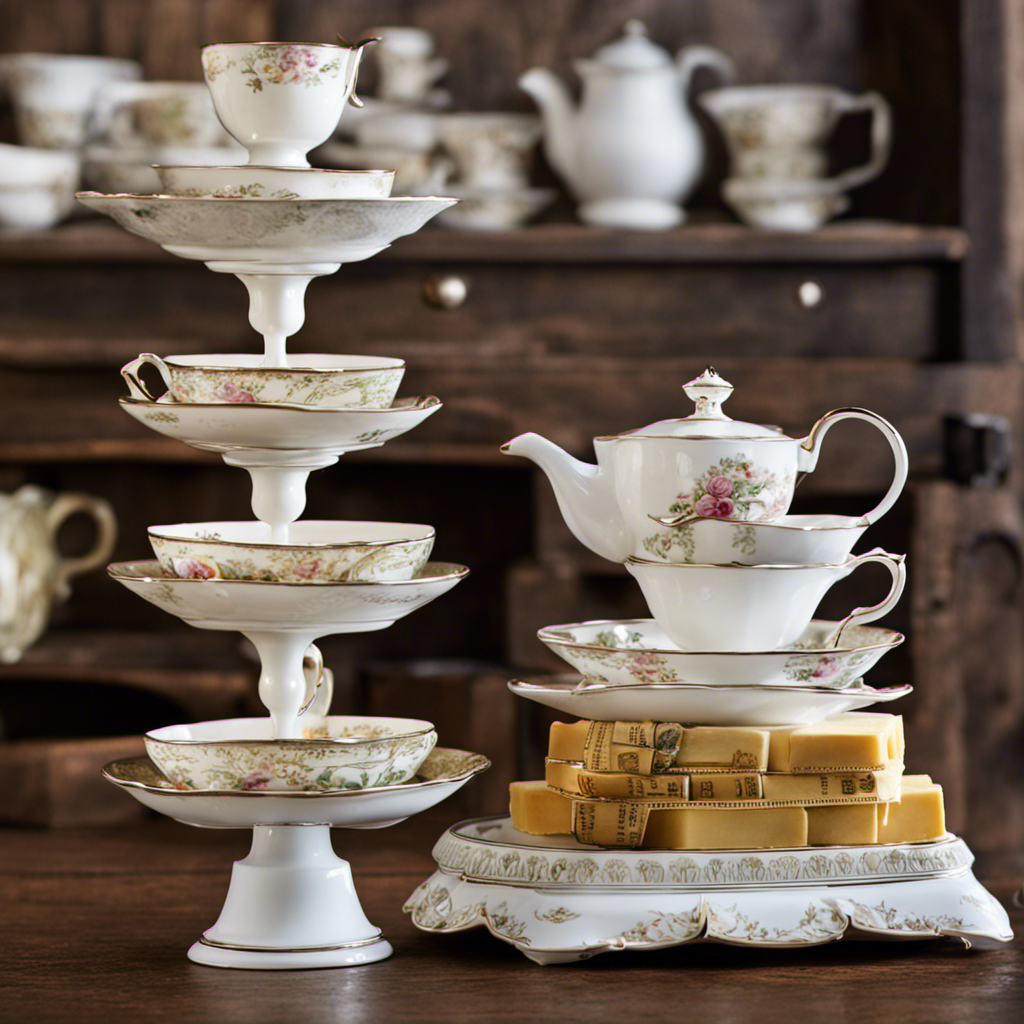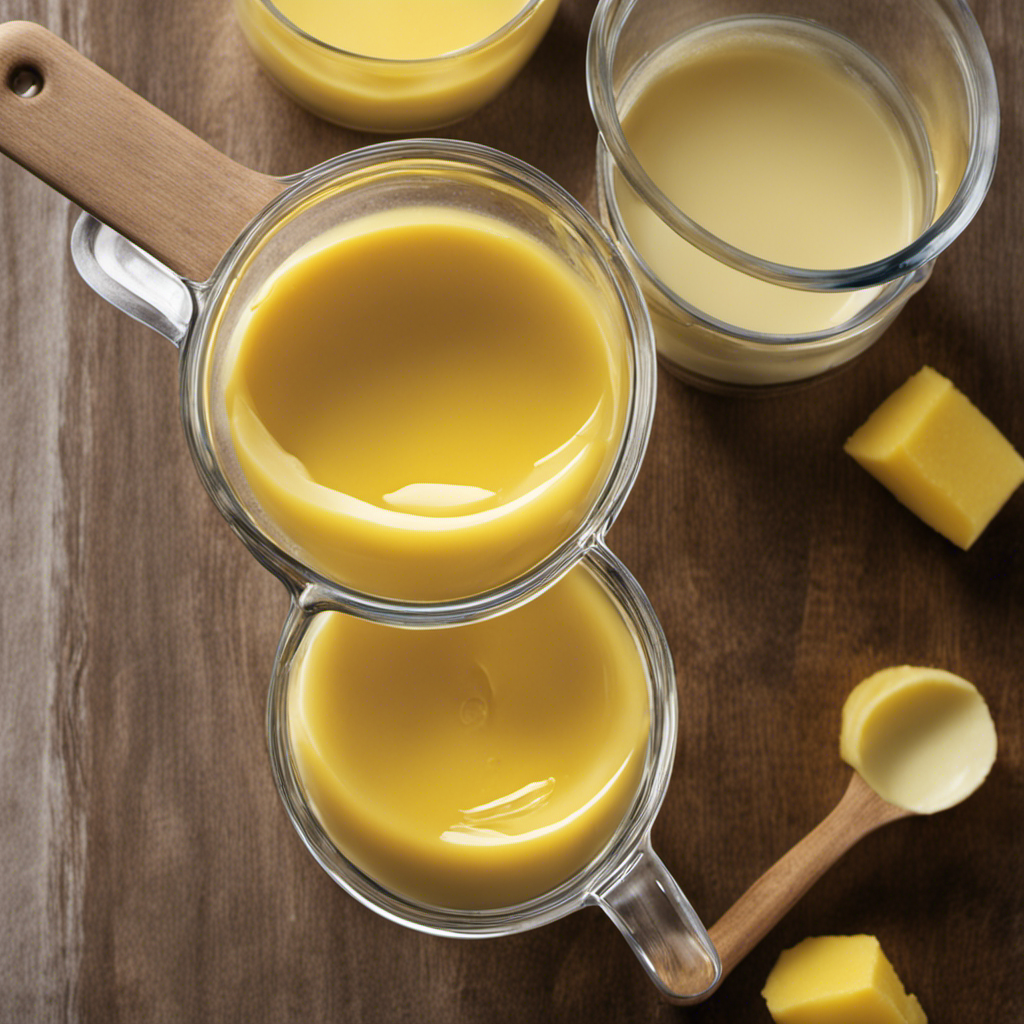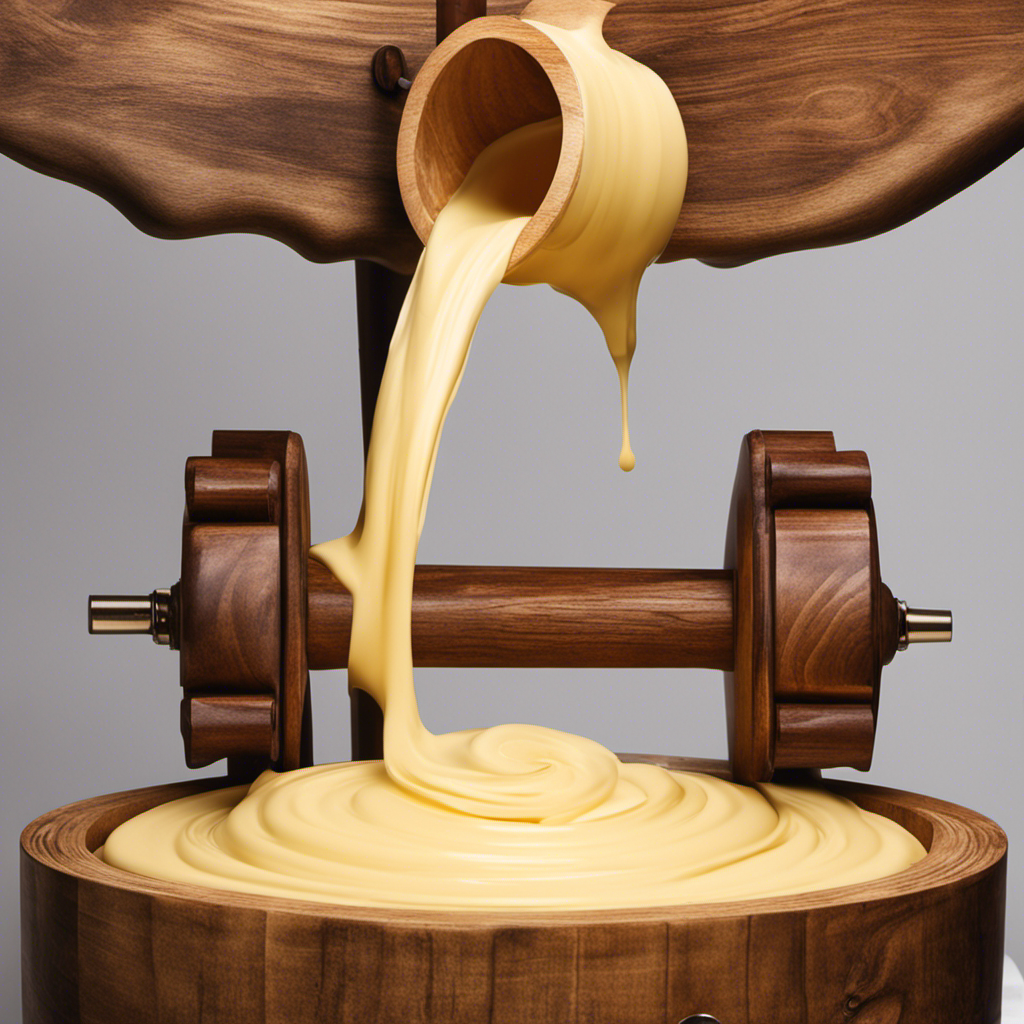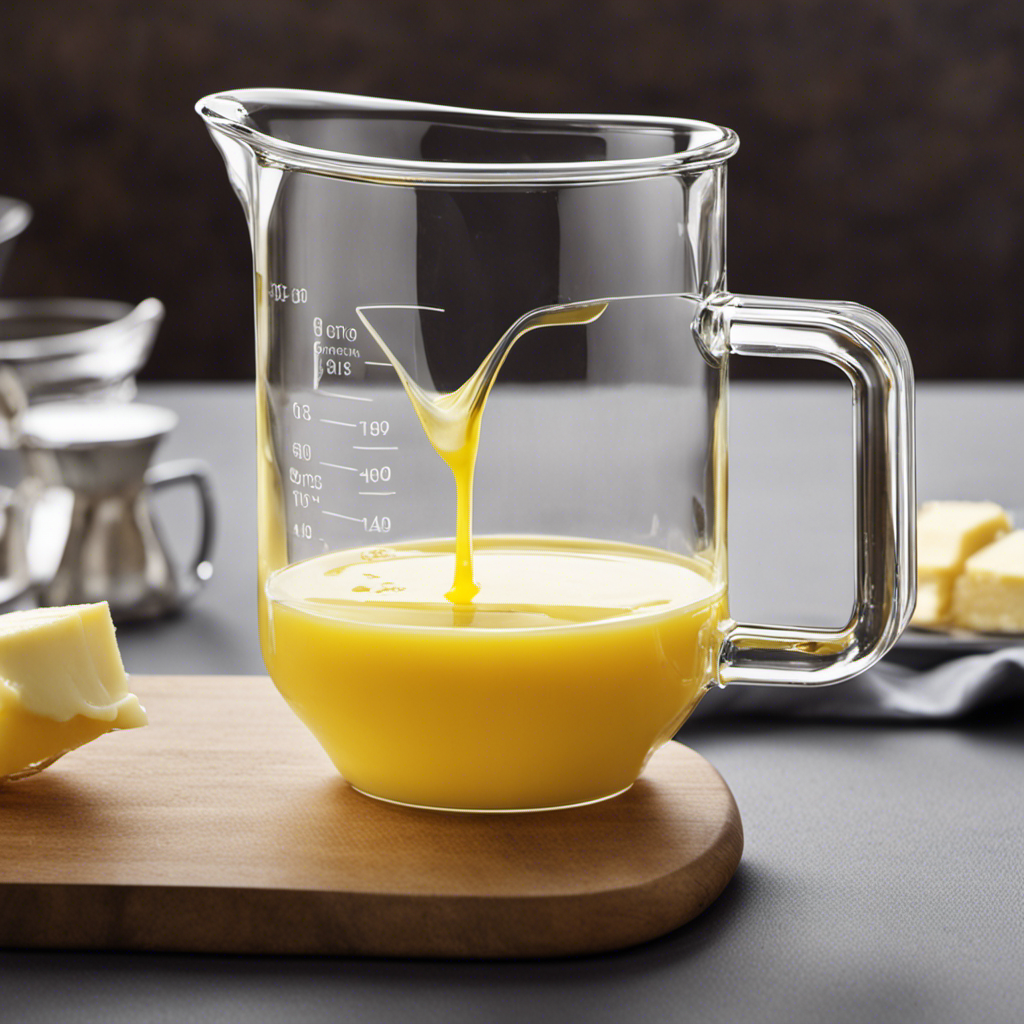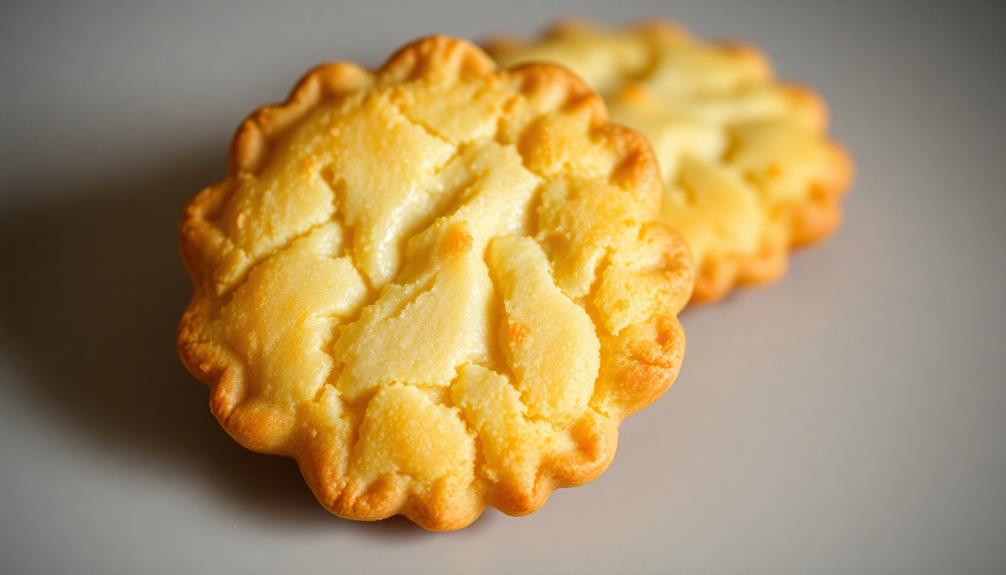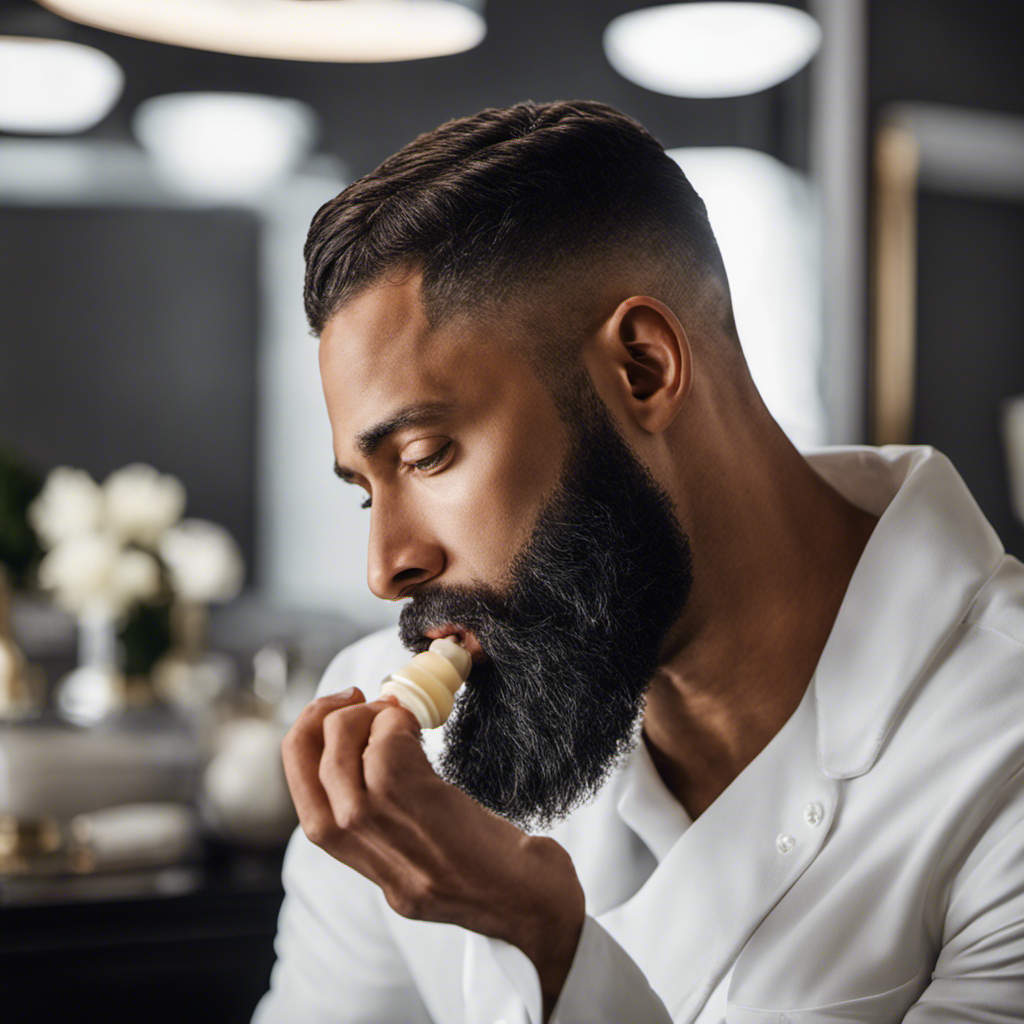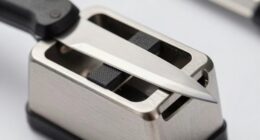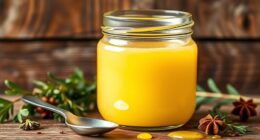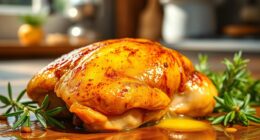Have you ever pondered the amount of cups of butter contained in a pound? Allow me to explain it to you.
In this article, I’ll be your culinary guide, providing you with all the information you need to know about converting butter measurements. From understanding the conversion ratio to exploring the role of butter in baking, we’ll cover it all.
So, grab your apron and get ready to dive into the delicious world of buttery measurements!
Key Takeaways
- There are 2 cups of butter in a pound.
- Butter is typically measured in sticks, tablespoons, or cups.
- Adjusting the amount of butter based on the recipe’s requirements ensures desired taste and texture.
- Butter is usually sold in sticks, with each stick weighing 1/2 cup or 8 tablespoons.
Understanding the Conversion Ratio
To understand the conversion ratio, you’ll need to know that there are 2 cups of butter in a pound. When it comes to measuring butter, it’s essential to have a clear understanding of the butter to pound ratio. This knowledge will help you accurately convert measurements and ensure the success of your recipes.
Whether you’re baking a cake or making savory dishes, knowing how much butter to use is crucial. Conversion methods play a significant role in achieving the desired texture and flavor in your culinary creations. Understanding the butter to pound ratio allows you to make precise calculations and maintain the right balance of ingredients.
Now that we have grasped the conversion ratio, let’s delve into the importance of knowing measurements in the next section.
The Importance of Knowing Measurements
Knowing measurements is important because it allows you to accurately follow recipes and achieve the desired outcome. Precision is key in the culinary world, and even the slightest deviation from a recipe can have a significant impact on the final result. Whether it’s a pinch of salt or a cup of flour, every ingredient plays a crucial role in creating a harmonious balance of flavors and textures. Inaccurate measurements can lead to disastrous results – a cake that doesn’t rise, bread that is too dense, or a sauce that is too salty. To emphasize the importance of precision, let’s take a look at the table below, which illustrates the impact of inaccurate measurements on three common baking ingredients: flour, sugar, and baking powder.
| Ingredient | Correct Measurement | Inaccurate Measurement | Result |
|---|---|---|---|
| Flour | 1 cup | 1 1/2 cups | Dry and crumbly |
| Sugar | 1/2 cup | 1/4 cup | Less sweet |
| Baking Powder | 1 teaspoon | 1 tablespoon | Bitter taste |
As you can see, even a slight difference in measurements can have a significant impact on the outcome of your dish. So, next time you’re in the kitchen, remember the importance of precision and take the time to measure accurately. Your taste buds will thank you!
Converting Pounds to Cups: A Quick Guide
As a culinary expert, it’s important to understand butter measurement equivalents, accurately convert pounds to cups, and avoid common conversion mistakes.
When it comes to butter, knowing the correct measurements can make or break a recipe.
Converting pounds to cups requires precision, as slight variations can affect the final outcome of a dish.
Butter Measurement Equivalents
There’s no need to worry about converting measurements when it comes to butter – there are 2 cups in a pound!
Understanding butter density is essential when converting butter measurements for savory recipes. Butter, with its rich and creamy texture, adds a delightful flavor to a variety of dishes.
Whether you’re making a classic buttery sauce or baking a batch of cookies, knowing the correct measurements is crucial for achieving the desired results. When a recipe calls for a specific weight of butter, such as pounds, it’s helpful to know that a pound of butter is equivalent to 2 cups.
This knowledge allows you to easily convert the measurements without any hassle. So go ahead, dive into your favorite recipes and enjoy the deliciousness that butter brings.
Converting Pounds Accurately
Converting pounds accurately can be a challenge when it comes to measuring butter for different recipes. Understanding conversions is essential in order to get the right amount of butter needed for your culinary creations.
To convert pounds to cups, it is important to know that one pound of butter is equal to two cups. This conversion is based on the fact that each cup of butter weighs approximately 8 ounces, and there are 16 ounces in a pound. By knowing this conversion, you can accurately measure the amount of butter needed for your recipe.
However, it is crucial to remember that butter is often sold in sticks, with each stick weighing 1/2 cup or 4 ounces. So, if your recipe calls for a certain number of cups, you will need to adjust accordingly.
Now that we have a basic understanding of conversions, let’s explore some common conversion mistakes and how to avoid them.
Common Conversion Mistakes
To avoid common conversion mistakes, make sure you understand the correct measurements for different ingredients in your recipes. Converting measurements accurately is crucial in cooking and baking. Here are some tips to help you avoid common conversion mistakes:
-
Understand the conversion ratios: Different ingredients have different conversion ratios. For example, 1 cup of flour is equal to 120 grams, while 1 cup of butter is equal to 227 grams.
-
Use a reliable conversion chart: Keep a conversion chart handy to reference when converting measurements. This will ensure accuracy and consistency in your recipes.
-
Be mindful of liquid vs. dry ingredients: Liquid and dry ingredients are measured differently. Use liquid measuring cups for liquids and dry measuring cups for dry ingredients to get precise measurements.
-
Double-check your calculations: Before adding an ingredient to your recipe, double-check your calculations to prevent any errors.
-
Practice and experiment: The more you cook and bake, the better you’ll get at converting measurements accurately. Practice makes perfect!
The Role of Butter in Baking
Butter plays a crucial role in baking, adding richness and flavor to various recipes. When it comes to the science of butter in baking, its impact on texture and flavor cannot be underestimated.
Butter is made up of fat, water, and milk solids, and its unique composition plays a significant role in creating the desired texture in baked goods. The fat in butter helps to tenderize the dough or batter by coating the gluten proteins, resulting in a softer and more tender final product.
Additionally, butter adds moisture and richness to baked goods, enhancing the overall flavor profile. The flavor of butter can vary depending on factors such as the breed of cows, their diet, and the production method.
From its creamy texture to its rich, buttery taste, butter truly is a versatile ingredient that elevates the quality of baked goods.
Common Recipes and Butter Measurements
When it comes to baking, getting the butter to recipe ratio right is crucial. Different recipes have different requirements for butter, and understanding how to convert butter measurements can be a game-changer in the kitchen.
In this discussion, we’ll explore the importance of butter to recipe ratio, the varying demands of different recipes, and how to easily convert butter measurements for successful baking every time.
Butter to Recipe Ratio
If you want to achieve the perfect butter to recipe ratio, you’ll need to know how many cups of butter are in a pound. To help you understand this better, here are some key points about butter measurement techniques and adjusting butter for different recipes:
- Butter is typically measured in sticks, tablespoons, or cups.
- One pound of butter is equal to 2 cups or 4 sticks.
- If a recipe calls for half a pound of butter, you’ll need 1 cup or 2 sticks.
- For recipes that require a quarter pound of butter, use 1/2 cup or 1 stick.
- It’s important to adjust the amount of butter based on the recipe’s requirements to ensure the desired taste and texture.
By understanding these butter measurement techniques, you can confidently adjust the butter in your recipes to achieve the perfect balance of flavors and textures.
Now, let’s explore the different recipe requirements and how they affect butter usage.
Different Recipe Requirements
In the world of baking and cooking, there are countless recipe variations that call for different amounts of butter. Sometimes, you may come across a recipe that requires a specific amount of butter, but you don’t have enough or you want to make a healthier substitution. Fear not, as there are several options for butter substitutions that can work just as well in your recipes.
One popular butter substitution is using coconut oil. It has a similar texture and can lend a subtle coconut flavor to your dishes. Another option is to use vegetable oil, which is a great choice for moist cakes and brownies. For a dairy-free alternative, you can use margarine or vegan butter.
It’s important to note that when substituting butter, you may need to adjust the quantity slightly to achieve the desired texture and taste. But with a little experimentation, you can find the perfect butter substitute for your recipe.
Now that we’ve explored different butter substitutions, let’s move on to the next topic: converting butter measurements.
Converting Butter Measurements
To convert butter measurements, all you need to do is use a simple ratio. Here are some butter measurement equivalents to help you in your baking adventures:
- 1 pound of butter is equal to 2 cups or 4 sticks.
- 1 cup of butter is equal to 2 sticks or 16 tablespoons.
- 1 stick of butter is equal to 1/2 cup or 8 tablespoons.
- 1 tablespoon of butter is equal to 1/2 ounce or 14.18 grams.
- 1 teaspoon of butter is equal to 1/6 ounce or 4.73 grams.
Converting butter measurements is essential for following recipes accurately. Whether you need to increase or decrease the amount of butter needed, understanding these equivalents will ensure successful results in your baking endeavors.
Baking Tips: Adjusting Butter for Different Recipes
There’s a helpful tip for adjusting butter in different baking recipes. When it comes to vegan recipes or if you simply want to cut down on butter, there are alternatives you can use that will still yield delicious results. Here’s a table to help you adjust the amount of butter needed in your baking:
| Recipe | Original Butter Amount | Alternative |
|---|---|---|
| Cookies | 1 cup | 1 cup coconut oil |
| Cake | 1/2 cup | 1/2 cup unsweetened applesauce |
| Brownies | 1 stick (1/2 cup) | 1/2 cup mashed avocado |
These alternatives not only provide a different flavor profile, but they also add moisture and richness to your baked goods. So next time you’re making a vegan recipe or want to reduce your butter intake, consider these alternatives. Now, let’s move on to measuring butter: weight vs. volume.
Measuring Butter: Weight Vs. Volume
When you’re measuring butter, it’s important to understand the difference between weight and volume. Butter is sold in both weight and volume measurements, and knowing how to convert between the two can greatly impact your cooking and baking. Here are some key points to keep in mind:
- Butter is denser than other ingredients, so a cup of butter will weigh more than a cup of flour or sugar.
- Weight measurements, such as ounces or pounds, are more accurate for butter than volume measurements like cups or tablespoons.
- To convert from weight to volume, use a conversion chart or scale to measure the desired amount of butter in ounces or pounds, and then refer to a conversion chart to determine the equivalent volume measurement.
- Volume measurements are commonly used in recipes, so it’s helpful to know some approximate conversions. For example, one stick of butter is usually equivalent to half a cup or 8 tablespoons.
- It’s always best to measure butter using the method specified in the recipe to ensure accurate results.
Understanding the difference between butter weight and volume is crucial for successful cooking and baking.
In the next section, we’ll explore how to convert butter measurements for different baking needs.
Converting Butter Measurements for Different Baking Needs
If you want to convert butter measurements for different baking needs, it’s helpful to know the equivalent volume for different weights of butter.
Butter is usually sold in sticks, and each stick typically weighs 1/2 cup or 8 tablespoons. So, if a recipe calls for 1 cup of butter, you’ll need 2 sticks or 16 tablespoons.
But what if you only have butter in grams or ounces? Well, 1 pound of butter is equal to 2 cups or 4 sticks. That means 1 cup of butter is about 227 grams or 8 ounces.
If you need to adjust the amount of butter for your recipe, it’s important to keep these conversions in mind. By understanding butter measurement conversions, you can confidently adjust the butter for your baking needs.
Butter Equivalents: Cups to Pounds
To convert cups of butter to pounds, you’ll need to know the equivalent weight for different measurements. Understanding conversions is crucial for accurate baking and cooking. Here’s a helpful breakdown:
- 1 cup of butter is equal to 0.5 pounds.
- 2 cups of butter make 1 pound.
- 4 cups of butter are equivalent to 2 pounds.
- If you have 8 cups of butter, that’s 4 pounds.
- And finally, 16 cups of butter weigh 8 pounds.
Having a clear understanding of these conversions ensures the accuracy of your recipes and the deliciousness of your baked goods. Butter measurement accuracy is key to achieving the desired texture and flavor in your dishes.
Now that you know the equivalents, let’s delve into how to measure butter: tips and techniques.
How to Measure Butter: Tips and Techniques
A helpful technique for measuring butter accurately is by using a kitchen scale. This ensures precise measurements, especially when baking, where accuracy is crucial.
Understanding the importance of butter consistency is also key. Butter can come in different forms – sticks, blocks, or tubs – and each has its own measurement conversions. For example, 1 stick of butter is equal to 1/2 cup or 8 tablespoons. If a recipe calls for 1 cup of butter, you would need 2 sticks.
It’s important to note that butter should be at room temperature for accurate measuring. Softened butter is easier to work with and incorporates better into your recipes.
So, if you’re looking for tips on measuring butter accurately, invest in a good kitchen scale and make sure your butter is at the right consistency.
Happy baking!
Converting Butter Measurements: Commonly Asked Questions
Converting butter measurements can be confusing, but it’s important to understand the different forms of butter and their corresponding conversions.
Here are some tips for accurate butter measurements:
- Stick of Butter: In the United States, a standard stick of butter is 1/2 cup or 8 tablespoons.
- Pound of Butter: A pound of butter is equal to 2 cups or 4 sticks.
- Ounces of Butter: There are 16 tablespoons in a stick of butter, which is equivalent to 8 ounces.
- Grams of Butter: One stick of butter weighs approximately 113 grams.
- Metric Conversions: In metric measurements, 1 cup of butter is approximately 227 grams.
Frequently Asked Questions
Can I Substitute Margarine for Butter in a Recipe?
Sure, you can substitute margarine for butter in a recipe. Margarine has a similar fat content and can provide a similar texture and flavor. Just make sure to use a 1:1 ratio.
How Do I Convert Butter Measurements if I Only Have a Digital Scale?
When converting butter measurements using a digital scale, it’s important to know that 1 pound of butter is equal to 2 cups. Simply weigh the butter on your scale for accurate measurements.
Can I Use Salted Butter Instead of Unsalted Butter in Baking?
When baking, the choice between salted and unsalted butter affects both flavor and texture. While salted butter can be used, unsalted is preferred for more control over salt levels.
How Do I Store Leftover Butter After Measuring It for a Recipe?
To store leftover butter, wrap it tightly in plastic wrap or place it in an airtight container. This will prevent it from absorbing odors and going bad. Keep it in the refrigerator for up to two weeks.
Are There Any Alternative Options for Butter in Baking for Those With Dietary Restrictions?
When it comes to baking with dietary restrictions, there are plenty of alternative options to butter. Coconut oil, avocado, and applesauce can all be used as substitutes, adding a unique twist to your recipes.
Conclusion
In conclusion, understanding the conversion ratio of pounds to cups when it comes to butter is essential for any baker. It allows us to accurately measure and use the right amount of butter in our recipes.
Whether we’re making a rich and decadent cake or a flaky pie crust, knowing the proper measurements ensures the perfect outcome.
So go ahead, whip up a batch of your favorite treats and let the buttery goodness take center stage. Your taste buds will thank you for it!
